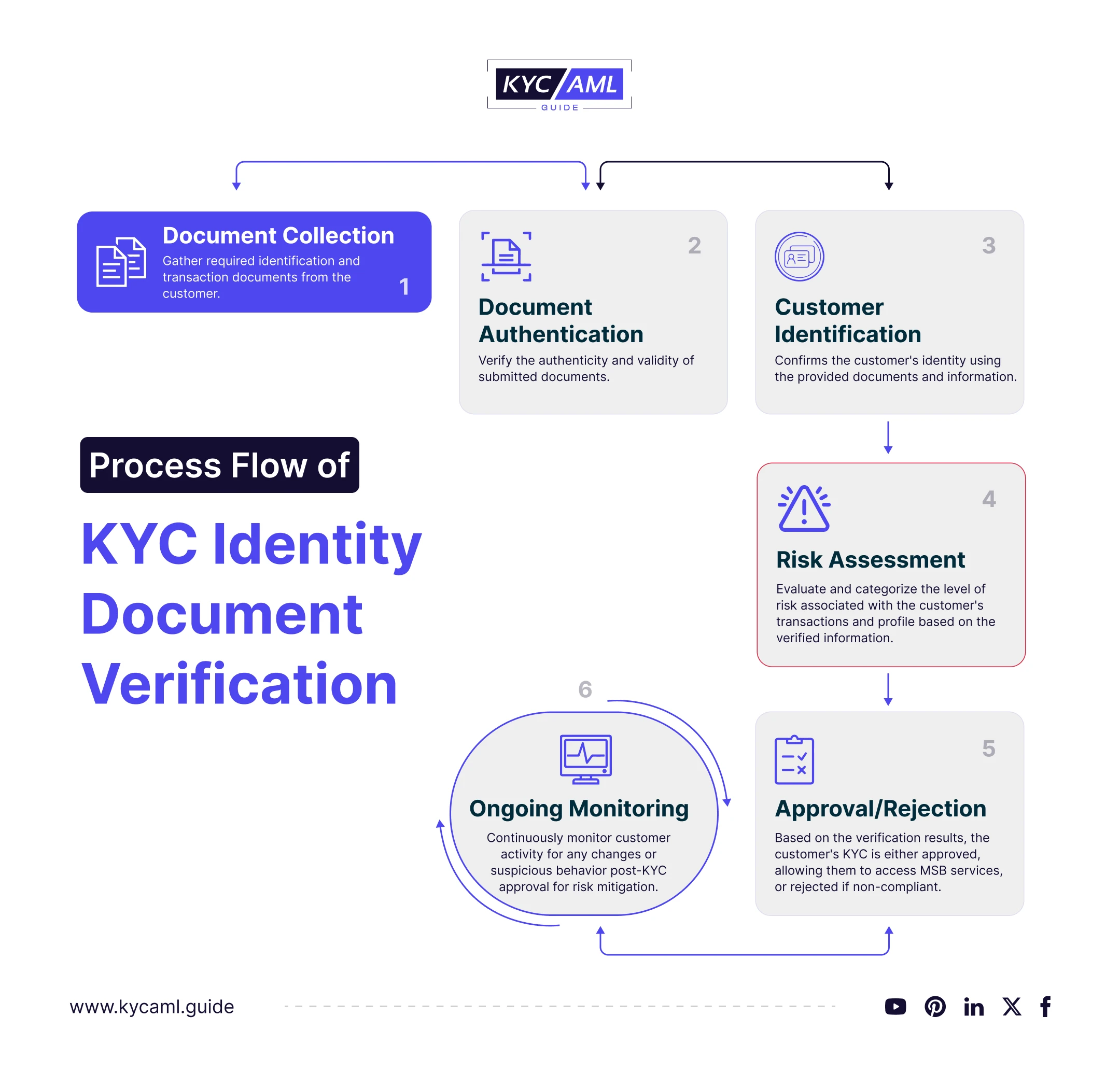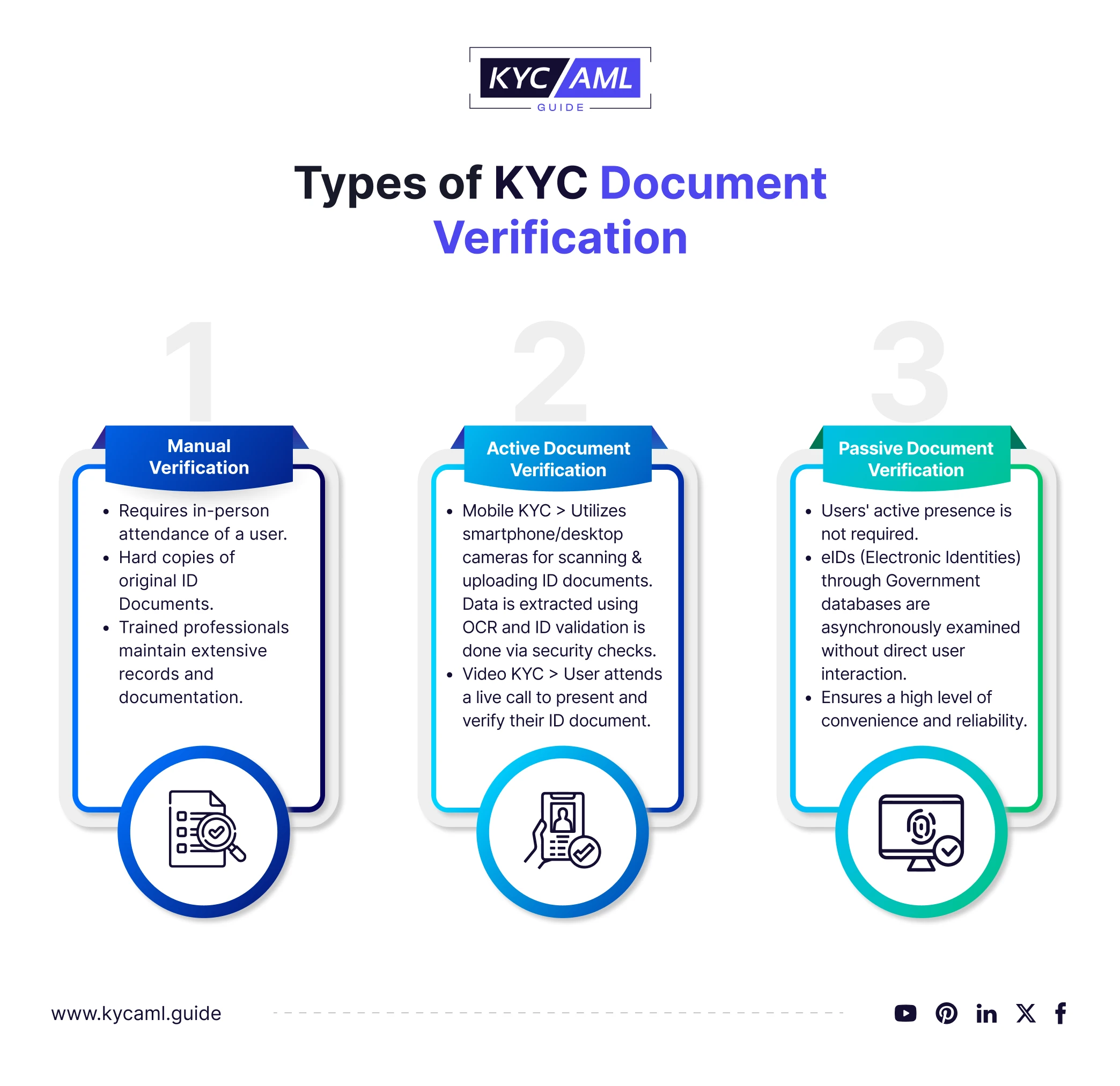What is KYC Document Verification?
It is a process of confirming customers’ identities by collecting, verifying, and authenticating documents that have identifiable information. In other words, KYC Document Verification is a process of verifying customer identity with the help of customer’s identity documents. These documents typically contain proof of identity (POI) like a government ID card, proof of address (POA) like utility bill & transaction history of the customer.
KYC Document Verification process explained
Document verification for a KYC (Know Your Customer) process has the following steps:

-
- Document Collection: Identity documents of customers are collected through various means. These documents include:
- Proof of Identity (PoI) > Government-issued ID card, SSN, Driving License, etc.
- Proof of Address (PoA) > Utility bills, Rent Agreement, etc.
- Proof of Income or Occupation (PoI/A) > Salary Slip, Income statement, etc.
- Transaction Record > Checks, Money orders, etc.
- Document Collection: Identity documents of customers are collected through various means. These documents include:
- Document Verification & Authentication: Submitted Identity documents are verified for accuracy, authenticity & completeness.
- Risk Assessment: Customer profiles are categorized into different risk levels according to the risk evaluation.
- Approval/ Rejection: Customers are onboarded successfully or in case of rejection, they are reported to the authorities.
- Ongoing Monitoring: Customer transactions and activities are regularly monitored to avoid any suspicious and risky activities.
Types of KYC Document Verification

| Manual Verification |
|
| Active Verification |
|
| Passive Verification |
|
Importance of KYC Document Verification
KYC Document Verification holds a pivotal place in the prevention of financial crimes like Money Laundering, Fraud, and Terrorism Financing. Authentic customers feel safe and secure while using the services of a financial institution or a bank if its KYC system is sophisticated and robust. Document Verification ensures that Identities are proven reliably. When a government-issued ID or another authentic and validated document is verified, it lessens the chances of the customer being fraudulent. Documents are proof of authenticity and carry considerable weight in the KYC process.
Industry-Specific Implications of KYC Document Verification
| Banking Sector |
|
| Cryptocurrency Market |
|
| Airport Security |
|
| Other Fintech companies |
|
Also read: KYC Document Verification in Crypto institutions
Future of KYC Identity Document Verification
KYC document verification is evolving with the rapid technological shift toward complete digitization and process automation. Many sectors now prefer having digital identities and documents in digital form or at least machine-readable form of hard copies. For example, NICOP, eID cards and driving licenses for identities, e-receipts, e-statements, and other electronic documents for transaction-related information, etc.
Here are a few predictions based upon the current prevailing and rising trends in the KYC pertinent to Document Verification:
Biometrics
It will keep evolving and become more efficient with the enhancement of biometric technologies. Facial recognition, voice recognition, etc. will become more efficient by enhancing the detection of anti-deep fake technology.
Blockchain
Blockchain technology will take over the databases of KYC identities worldwide in all regulated jurisdictions sooner or later. Decentralization is currently a preferred data storage mechanism by most of the KYC Vendors. Shortly, this practice will be embraced as a mandatory practice in the KYC and AML domains due to its inherent advantages.
AI (Artificial Intelligence) and ML (Machine Learning)
AI and ML are rapidly becoming a core integration with many technologies. In KYC, it will dominate the industry by integrating digital identities with AI and ML for full automation.
Mobile Verification
Smartphones are widely used now for KYC in many sectors and the practice will continue to grow and improve with improved mobile phone technologies.
Also read: KYC Document Verification in MSBs
Conclusion
KYC Document Verification remains a pillar of Customer Onboarding. Manual verification and active and Passive Verification are all types of KYC Document Verification and are implemented in different domains and sectors. It helps in the prevention of fraud and money laundering. Though it has a few challenges of its own, its evolution with emerging technologies is promising.





